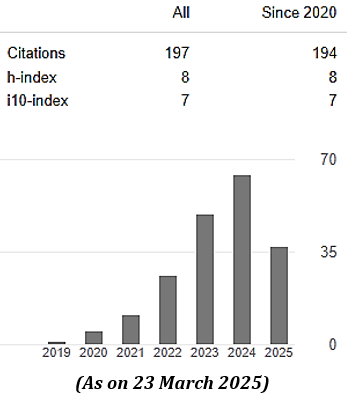EFFECTIVENESS OF DAMPERS IN ENHANCING THE LATERAL LOAD BEARING CAPACITY OF HIGH-RISE STEEL BUILDING
Abstract
This research paper describes the results of analysis of the seismic behavior of a thirty story steel building with and
without damper under different earthquake acceleration signals. The proposed procedure placed the various types of
damper like friction damper, bilinear damper and exponential damper on the top three floors of the building. The study
compares the different performances such as the joint displacement, joint acceleration, the base force of structure
with and without damper for a thirty-story steel building using ETABS 2015. The study further performs time history
analysis for different seismic accelerograms to observe the actual time domain responses of the structure. Finally,
static pushover analysis in both X and Y direction studies the demand and capacity spectrum. Linear time-history
analysis on this steel building structure indicates that maximum joint displacement increases for S-Monica2 seismic
accelerogram and decreases for Altadena and Corralit accelerograms; whereas, maximum base force and maximum
joint acceleration are effectively reduced for all the seismic accelerograms in the presence of damper at top three floors
of the building.
Downloads
References
[2] Khan W., Dr. S. Akhtar, A. Hussain (2014), “Non- linear time history analysis of tall structure for a seismic load using a damper,” International Journal of Scientific and Research Publications, Volume 4, Issue 4, ISSN 2250-3153, April 2014.
[3] Lopez I., J.M. Busturia, H. Nijmeijer (2003), “Energy dissipation of a friction damper,” Journal of Sound and Vibration, 278 (2004) 539–561, October 2003.
[4] Purasinghe R, Seismic Evaluation and Retrofit Of A Moment Frame Building With Viscous Dampers, Professor of Civil Engineering, California State University at Los Angeles, California
[5] Rao S-S (2011), “Mechanical Vibrations”, 5th-edition, ISBN 978- 0-13-21281-9-3, Lake Street, Upper Saddle River, Prentice Hall.
[6] Shaukat Khan Q, A. Ullah Case and M. Ilyas (2013), Improved Seismic Response of RC Frame Structures by Using Fluid Viscous Dampers, Pak. J. Engg. & Appl. Sci., July 2013, Vol. 13, (p. 8-18),
[7] Saiful Islam A.B.M., M. Jameel, Md. A. Uddin, M. Zamin Jumaat (2012), “Competent Building Elevation for Incorporating Base Isolation in Aseismic Structure,” presented at International Conference on Advances Science and Contemporary Engineering, ICASCE 2012.
[8] Thakur V.M and P.D. Pachpor (2012), “Seismic Analysis of Multistoried Building with TMD (Tuned Mass Damper),” International Journal of Engineering Research and Applications (IJERA), Vol. 2, ISSN: 2248-9622, Issue 1, pp. 319-326,
[9] Wolff E. D., E C. Ipek, M. C. Constantinou and M. Tapan (2014), “Effect of Viscous Damping Devices on the Response of Seismically Isolated Structures,” Published online in Wiley Online Library, DOI:10.1002/eqe.24643, 2014.
[10] Wong, K. F., and Johnson, J. G. (2009). Seismic Energy Dissipation of Inelastic Structures with Multiple Tuned Mass Dampers. Journal of Engineering Mechanics. 135(4), 265-275.
MIJST follows the open access policy.

This work is licensed under a Creative Commons Attribution-NonCommercial 4.0 International License. This allows anyone to copy, share, distribute, and modify the work for non-commercial purposes, where the original work and source should be properly credited.
















